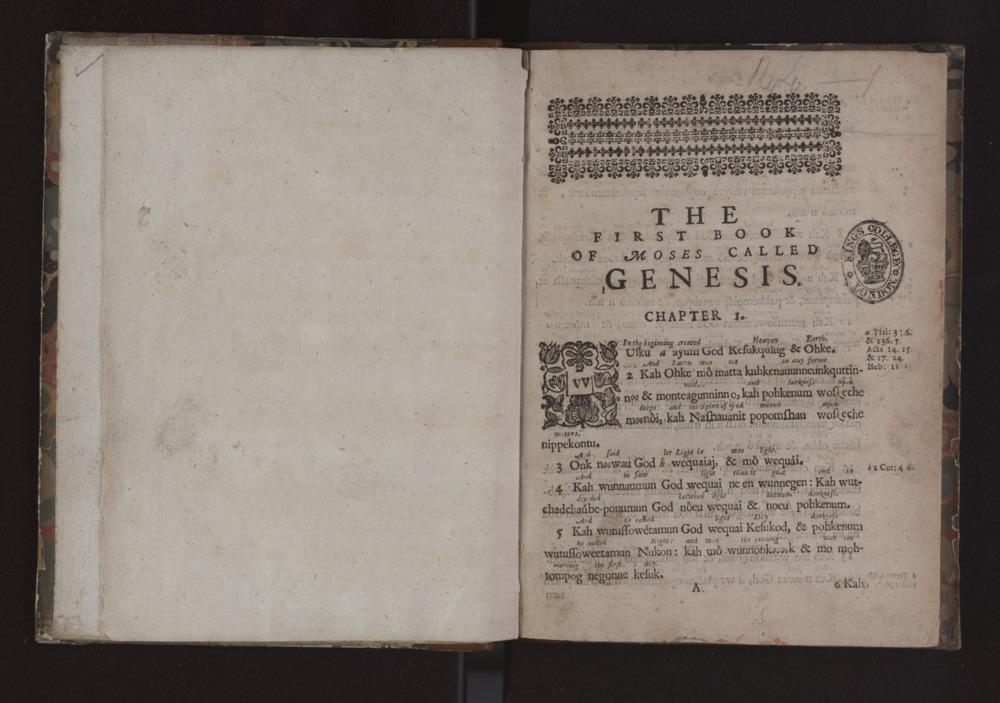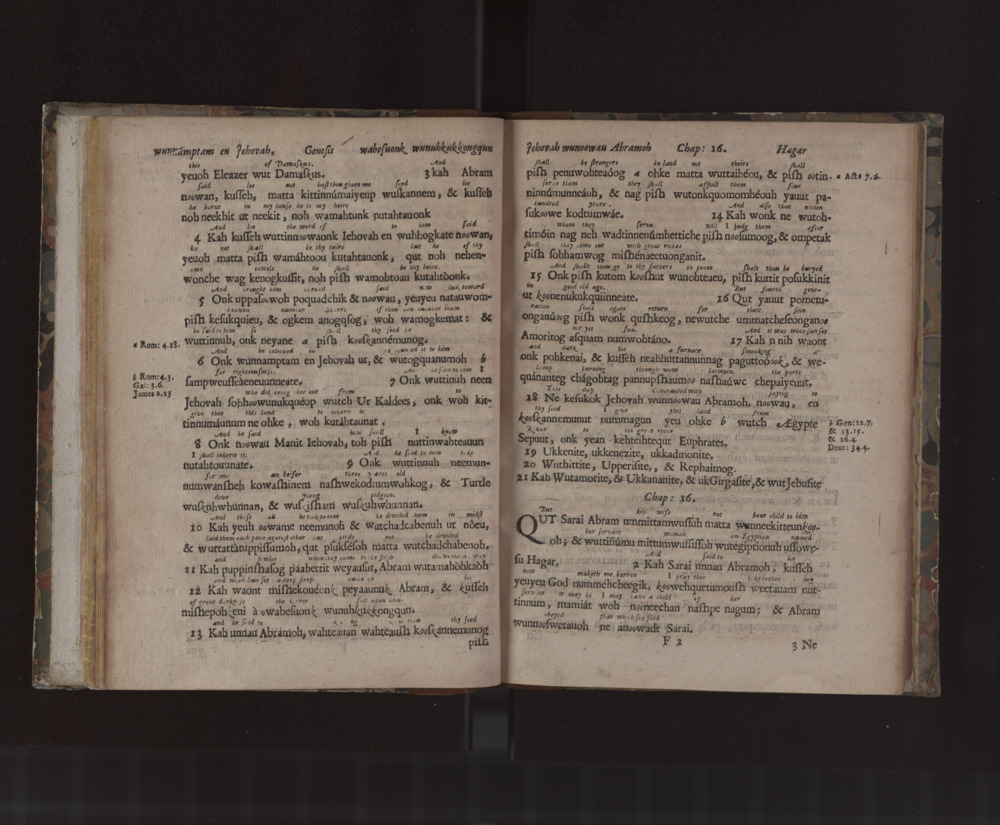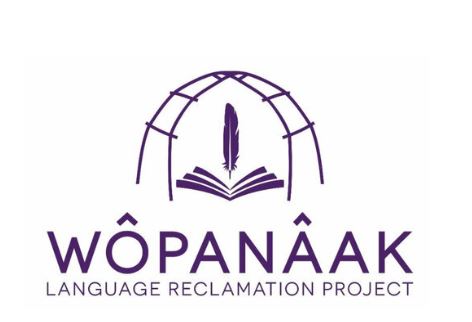By Jack Busby, Library Assistant, King’s College London
Over the course of three nights in the early 1990s Jesse Little Doe Baird had a series of visions. In the visions her ancestors from the Wampanoag tribe of Massachusetts spoke to her in a language she couldn’t understand. Later, whilst driving through Massachusetts, she saw a sign for Sippewissett, a Wampanoag word for ‘little river’ or ‘cove’, and realised that the reason she couldn’t understand the language spoken in her dreams was because her ancestors were speaking to her in Wôpanâak, the language of the Wampanoag tribe in Massachusetts, a language which by the 1990s was considered to be extinct.
 The Eliot Genesis, currently held in the Foyle Special Collections Library, King’s College London, is a phonetic translation of the first book of the Bible into Wôpanâak, a language which, up until the 17th century, had no written component.
The Eliot Genesis, currently held in the Foyle Special Collections Library, King’s College London, is a phonetic translation of the first book of the Bible into Wôpanâak, a language which, up until the 17th century, had no written component.
Named after the Puritan missionary John Eliot who oversaw its creation in 1655, The Eliot Genesis would have been used as a teaching aid, with detailed interlinear English text allowing English missionaries to read to Wôpanâak speakers in a language they could understand and still find their place.
In addition to this however, The Eliot Genesis also acted as a proof of concept for The Eliot Bible, a 1663 translation of the entire Bible into Wôpanâak. In this post I will be focusing on how both The Eliot Genesis and Bible were used by European colonisers to enact what Indigenous theologian Tink Tinker describes as a cultural genocide:
The effective destruction of a people by systematically or systemically […] destroying, eroding, or undermining the integrity of [a] culture and system of values that defines a people and gives them life.
It is important to note that both The Eliot Bible and The Eliot Genesis are also the result of Indigenous labour. Produced by Eliot and a team of Indigenous linguists, translators, and fact checkers, with varying levels of coercion, including John Sassamon, Job Nesutan, Cockenoe, and Wowaus (or James Printer), The Eliot Bible in particular was written for Indigenous readers, some of whom engaged with the texts on deep, personal levels, and as Fisher records, this is evidenced by the extensive marginalia found in Eliot’s Bible.
The amount of choice these linguists had in whether they performed this work, given the colonial context in which they were operating, should be taken into account, especially in the case of Cockenoe, Eliot’s servant/slave, who would have worked with Eliot on both the Genesis and The Eliot Bible. It is important to acknowledge the work that these Indigenous linguists put into the creation of these texts and their roles in the creation of the first Bible printed in an Indigenous language.
To understand how both The Eliot Genesis and The Eliot Bible and were tools in the cultural genocide of the Wampanoag it is useful to look into the history of The New England Company, a Puritan missionary group who helped fund the creation of The Eliot Bible. According to The New England Company’s website, they:
[were] founded in 1649 to propagate the gospel to the native peoples in His Majesty’s Dominions in North America, sending missionaries and teachers to New England, New York and Virginia
In an e-book, promoted on The New England Company’s history page, titled Come over and help us: The New England Company and its mission 1649-2001 Neil Hitchen writes:
Puritanism was a form of faith which depended on the written word of God, since intellectual consent to the truths of the Gospel was the basis of the necessary conversion experience. […] Unlike the Catholic church which, because it was liturgical rather than literate, could travel more easily with a migrating people, literate Puritan Christianity, required books and therefore libraries, and a settled people who were capable of reading.
The Indians were neither settled nor had a written language, and the early decades of the Company’s missions were devoted to finding ways to settle and educate them. One of the first tasks the early missionary John Eliot set himself was to translate the bible into Algonquian [sic], the local Massachusetts dialect, a project the Company supported and paid for.
‘Settling’ in the context of John Eliot’s mission involved the imposition of European systems of land management, town planning, and colonial expansion onto the Indigenous people of Massachusetts, undermining pre-existing cultures and value systems present in Indigenous communities. This settling was an inherently European supremacist project which saw Indigenous people and Indigenous culture as lesser than the people and culture of the European colonies.
One prominent example of settling are the ‘praying towns’ set up by Eliot across Massachusetts, which were villages where Indigenous converts were separated from Indigenous communities to live amongst other Indigenous Christian converts. As a prerequisite for living in these towns Indigenous people were required to leave their homes, cut their hair, adopt European dress, and live in nuclear family units, destroying their established familial bonds and severing their links with the Indigenous people in the area.
In doing this the praying towns were positioned as subservient to, and dependent upon, the economies of the segregated white European towns whose economies were themselves based upon exploiting land and resources stolen from Indigenous people, pulling the inhabitants of the praying towns into a ‘vortex of dependence on the economic structures of the colony, which had in mind only economic exploitation of native resources.’
It is not hard to see how the European colonies of Massachusetts would have benefited from this arrangement and so it’s entirely unsurprising that John Eliot’s missions were funded in part by those colonies.
In Hitchen’s description of the missionary work of John Eliot, this ‘settling’ is then linked to education, and is described by Hitchen as a process of teaching Indigenous people to read Wôpanâak in order to study The Eliot Bible. Passages such as: ‘literate, Puritan Christianity, required […] a settled people who were capable of reading’ expose how, for Eliot’s Puritan mission, it was essential for Indigenous people to reject the lives they had lived before the arrival of European colonisers in order to learn how to read The Eliot Bible and ‘consent to the truths of the Gospel’
The Eliot Genesis and The Eliot Bible, rather than being books passively created within the context of colonialism, are therefore active tools in the erosion of Indigenous culture and the cultural genocide described by Tinker. As outlined by Hitchen, John Eliot’s missionary work saw education and settling (teaching of the bible and undermining Indigenous culture) as two sides of the same coin, with one only existing in order to fulfil the objectives of the other.
This relationship was clearly understood by the Wampanoag who, during King Philip’s War, in 1675 protested against colonial rule by destroying copies of The Eliot Bible. This armed conflict led by Metacomet a sachem or chief who was unable to prevent the erosion of Wampanoag culture instigated by Eliot and over 300 years later, Wôpanâak, the language of The Eliot Genesis and The Eliot Bible, was considered to be extinct.
There is a Wampanoag prophecy that ‘speaks of a time when the language would leave the Wôpanâak but also of a time when it would return if the people desired its homecoming.’ (Wôpanâak Langage Reclamation Project).
Jesse Little Doe Baird took her visions in the early 1990s as a sign and over the next few decades worked with academics at Harvard university to reconstruct Wôpanâak using the languages still spoken by Native Massachusetts people as reference points. In addition to this, her work involved studying documents written in Wôpanâak. A core text in this process was The Eliot Bible.
By 2011, Jessie Little Doe Baird’s daughter Mae was the first native speaker of Wôpanâak in seven generations.
More information about the work of the Wôpanâak Language Reclamation Project can be found on their website: https://www.wlrp.org/
Bibliography.
N Blackhawk. The rediscovery of America: Native peoples and the unmaking of US history. New Haven and London: Yale University Press, 2023
LD Fisher ‘American’s First Bible: Native uses, abuses, and re-uses of the Indian Bible of 1663’, in Goff, P (ed) The Bible in American life. Oxford: Oxford University Press, pp 35-47, 2017
N Hitchen ‘Come Over and Help Us’ The New England Company and its Mission 1649-2001.[https://newenglandcompany.org/wp-content/uploads/2024/05/COMEOVER- AND-HELP-US-BOOKLET.pdf] Accessed: 29/07/2024
John Eliot’s Genesis of 1655’ on JSTOR Open Collections https://www.jstor.org/stable/community.35643149 Accessed 29/07/2024
King’s College London Archives and Special Collections online exhibitions ‘John Eliot’s Genesis of 1655’ https://kingscollections.org/exhibitions/specialcollections/eliots-genesis
The New England Company (no date) Available at: [https://newenglandcompany.org/our-history/] Accessed 29/07/2024
GE Tinker. Missionary conquest: The gospel and Native American cultural genocide. Minneapolis: Fortress Press, 1993
We Still Live Here: Âs Nutayuneân. [Daily Motion]. Directed By Anne Makepeace. America: PBS, 2011
Wôpanâak Langage Reclamation Project. [https://www.wlrp.org/project-history] Accessed 29/07/2024

